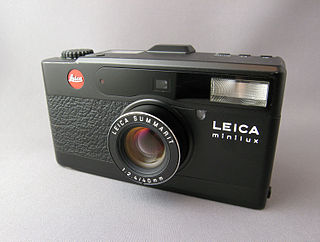

The name Elmar is used by Leica to designate camera lenses of four elements.


The name Elmar is used by Leica to designate camera lenses of four elements.
The Elmar lenses originally had a maximum aperture of f/3.5. These lenses were derived from a 50 mm f/3.5 Elmax lens first produced in 1925. The name is a combination of Ernst Leitz and Max Berek. [1]
Elmar lenses have a maximum aperture ranging between f/2.8 and f/4. Current Elmar lenses have a maximum aperture of f/3.8 or f/4, as in the Elmar-M 24 mm f/3.8 and Tri-Elmar-M 16-18-21 mm f/4. [1] The term Elmar is sometimes combined with: Super, Tele, APO, Macro or Vario. Leica also uses the name Elmarit for some lenses.
Elmar lenses are comparatively slow. As a result they tend to be smaller and lighter than faster lenses of the same focal length. [1] [2]

A rangefinder camera is a camera fitted with a rangefinder, typically a split-image rangefinder: a range-finding focusing mechanism allowing the photographer to measure the subject distance and take photographs that are in sharp focus.

The Four Thirds System is a standard created by Olympus and Eastman Kodak for digital single-lens reflex camera (DSLR) design and development. Four Thirds refers to both the size of the image sensor (4/3") as well as the aspect ratio (4:3). The Olympus E-1 was the first Four Thirds DSLR, announced and released in 2003. In 2008, Olympus and Panasonic began publicizing the Micro Four Thirds system, a mirrorless camera system which used the same sensor size; by eliminating the reflex mirror, the Micro Four Thirds cameras were significantly smaller than the Four Thirds cameras. The first Micro Four Thirds cameras were released in 2009 and the final Four Thirds cameras were released in 2010; by that time, approximately 15 Four Thirds camera models had been released by Olympus and Panasonic in total. The Four Thirds system was quietly discontinued in 2017, six years after the final cameras were released.

Macro photography is extreme close-up photography, usually of very small subjects and living organisms like insects, in which the size of the subject in the photograph is greater than life-size . By the original definition, a macro photograph is one in which the size of the subject on the negative or image sensor is life-size or greater. In some senses, however, it refers to a finished photograph of a subject that is greater than life-size.

Jos. Schneider Optische Werke GmbH is a manufacturer of industrial and photographic optics. The company was founded on 18 January 1913 by Joseph Schneider as Optische Anstalt Jos. Schneider & Co. at Bad Kreuznach in Germany. The company changed its name to Jos. Schneider & Co., Optische Werke, Kreuznach in 1922, and to the current Jos. Schneider Optische Werke GmbH in 1998.

The Pentax K-mount, sometimes referred to as the "PK-mount", is a bayonet lens mount standard for mounting interchangeable photographic lenses to 35 mm single-lens reflex (SLR) cameras. It was created by Pentax in 1975, and has since been used by all Pentax 35 mm and digital SLRs and also the MILC Pentax K-01. A number of other manufacturers have also produced many K-mount lenses and K-mount cameras.
Walter Mandler was a lens designer of Ernst Leitz Canada in Midland, Ontario. Mandler is credited with the design of more than 45 Leica lenses for the Leica rangefinder cameras and Leica SLR cameras.

The Leica CL is a 35mm compact rangefinder camera with interchangeable lenses in the Leica M-mount. It was developed in collaboration with Minolta who manufactured it. It first appeared in April 1973 and was released in the Japanese market in November 1973 as the Leitz Minolta CL. Both the Leica CL and Leitz Minolta CL were manufactured in a new Minolta factory in Osaka. In 2017, Leica announced a new digital mirrorless camera, again named Leica CL.

The name Elmarit is used by Leica to designate camera lenses that have a maximum aperture of f/2.8.
Cosina Voigtländer refers to photographic products manufactured by Cosina under the Voigtländer name since 1999. Cosina leases rights to the Voigtländer name from RINGFOTO GmbH & Co. ALFO Marketing KG in Germany. Cosina Voigtländer products have included 35mm film SLR and rangefinder camera bodies, and lenses for the M39 lens mount, M42 lens mount, Leica M mount, and other lens mounts.

The name Summicron is used by Leica to designate camera lenses that have a maximum aperture of f/2 after 1953 and to present day.

The Leica SL is a full-frame mirrorless interchangeable-lens camera announced by Leica Camera AG on 20 October 2015. The SL was promoted as a camera system for professional applications. Beside the Leica S-System, the Leica SL-System was the 2nd professional camera system in the company's product portfolio.

The Panasonic Leica DG Vario-Elmar 100–400 mmf/4.0-f/6.3 lens is a digital compact telephoto zoom lens for Micro Four Thirds system cameras. It is a varifocal lens branded with the German label Leica, but is currently manufactured in China by Panasonic, previously Japan.

The Leica L-Mount is a bayonet mount developed by Leica Camera AG for interchangeable-lens autofocus digital cameras.

The name Summilux is used by Leica and Panasonic Lumix to designate camera lenses that have a maximum aperture brighter than f/2, typically at f/1.4, but dimmer than f/1.0. The lens has been in production since 1959 and carries on to the present day.

The name Summarit is used by Leica to designate camera lenses that have a maximum aperture of f/2.4. The name has been in used since 1949.
The Leica S-System is a medium format digital single lens reflex camera system introduced by Leica Camera in 1996. Beginning with the Leica S1, a prototype top-end studio digital camera unveiled at Photokina 1996. It went into production at the end of 1997.

The Leica minilux is the first in a series of four luxury titanium-clad point and shoot cameras that were produced by Leica Camera starting from 1995; it is equipped with a high-quality lens and body to compete with similar premium compact cameras produced during the Japanese bubble-economy era, including the Contax T line, Konica Hexar, Nikon 28Ti/35Ti, Minolta TC-1, Ricoh GR series, and Rollei QZ 35W/35T. All of the cameras in the minilux series, including the original minilux, Leica minilux zoom (1998), Leica CM (2004), and Leica CM ZOOM used 35 mm film; the minilux and CM were equipped with the same Leica Summarit lens, while the minilux zoom and CM Zoom were equipped with a Vario-Elmar lens.